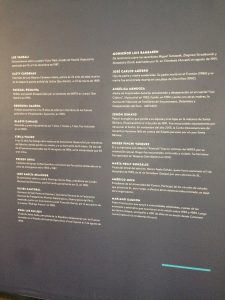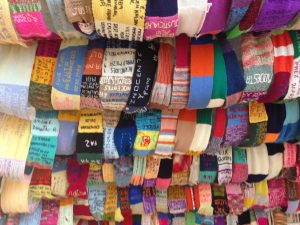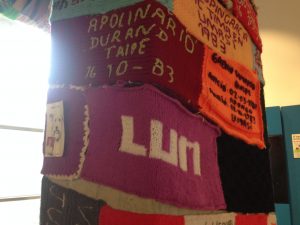Today after finishing my class at the university, I had the chance to stop by a museum right here in Miraflores – El Lugar de la Memoria, la Tolerancia y la Inclusión Social (The Place of Memory, Tolerance and Social Inclusion). I had been wanting to check this museum out ever since seeing Claudia Llosa’s film La Teta Asustada (The Milk of Sorrow) in my IFSA-Butler Advanced Writing course and learning about the violence that took place in Ayacucho (an area in south-central Perú) as a result of the Sendero Luminoso and MRTA (Túpac Amaru Revolutionary Movement). Before visiting the museum, I had been thinking a lot about how we recuperate memories of the past and the importance of looking back at the past in order to be able to reflect on history and ultimately improve for the future. Despite the difficulty that is presented to us upon looking back at the ugly parts of a country’s history, it is ultimately what helps us to fully understand and be well informed about society. For this reason, going to El Lugar de la Memoria was a very enriching experience for me, as I was able to enhance my understanding of Perú’s past through the photographs I saw and the audios that I heard.
The museum consists of three floors and a basement. The first floor is devoted to Perú during the years of 1980-2000, showing the origins of this violent era as well as how it impacted the educational system. Also, something which I really liked on the first floor was that there were testimonies from actual people who were victims of the violence inflicted by terrorists in the country. Hearing people from different communities throughout the country share their own stories in these testimonies was really moving to me because they were speaking their personal truths (See the photo below to read brief descriptions of each person’s testimony).
I actually spent a lot of time checking out the first floor today and decided that I am going to return to the museum another day in order to check out the second and third floors more thoroughly. I will probably make another post later on that connects to this post so that I can follow-up and describe more about the second and third floors.
As I already mentioned, the museum itself is a lot to take in at once considering that this was a very difficult part of Perú’s history. Thus, it can be extremely tough for Peruvians to revisit this traumatic past and even my host parents here have made it very clear to me that they have absolutely no interest in visiting the museum.
Here are some photos that I took during my visit to the museum (not too many actually because it didn’t feel like the kind of museum visit where you really want to take pictures). The first photo I’ve included is the one with the descriptions of different victims testimonies, as mentioned in the above post: 


